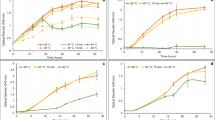Abstract
Phytases release inorganic phosphates from phytate in soil. A gene encoding phytase (AfPhyA) was isolated from Aspergillus ficuum and its ability to degrade phytase and release phosphate was demonstrated in Saccharomyces cerevisiae. A promoter from the Arabidopsis Pky10 gene and the carrot extensin signal peptide were used to drive the root-specific and secretory expression of the AfPhyA gene in soybean plants. The phytase activity and inorganic phosphate levels in transgenic soybean root secretions were 4.7 U/mg protein and 439 μM, respectively, compared to 0.8 U/mg protein and 120 μM, respectively, in control soybeans. Our results demonstrated the potential usefulness of the root-specific promoter for the exudation of recombinant phytases and offered a new perspective on the mobilization of phytate in soil to inorganic phosphates for plant uptake.



Similar content being viewed by others
References
Chen RM, Xue GX, Chen P et al (2008) Transgenic maize plants expressing a fungal phytase gene. Transgenic Res 17:633–643
Chomczynski P, Sacchi N (2006) The single-step method of RNA isolation by acid guanidinium thiocyanate-phenol-chloroform extraction: twenty-something years on. Nat Protoc 1:581–585
Hayes JE, Simpson RJ, Richardson AE (2000) The growth and phosphorus utilization of plants in sterile media when supplied with inositol hexaphosphate, glucose 1-phosphate or inorganic phosphate. Plant Soil 220:165–174
Heinonen JK, Lahti RJ (1981) A new and convenient colorimetric determination of inorganic orthophosphate and its application to the assay of inorganic pyrophosphatase. Anal Biochem 113:313–317
Kostrewa D, Gruninger-Leitch F, Arcy AD (1997) Crystal structure of phytase from Aspergillus ficuum at 2.5 Å resolution. Nat Struct Biol 4:185–190
Li XL, Ljungdahl LG (1996) Expression of Aureobasidium pullulans xynA in and secretion of the xylanase from Saccharomyces cerevisiae. Appl Environ Microbiol 62:209–213
Lung SC, Lim BL (2006) Assimilation of phytate-phosphorus by the extracellular phytase activity of tobacco (N. tabacum) is affected by the availability of soluble phytate. Plant Soil 279:187–199
Nitz I, Berkefeld H, Puzio PS et al (2001) Pyk10, a seedling and root specific gene and promoter from Arabidopsis thaliana. Plant Sci 161:337–346
Richardson AE, Hadobas PA, Hayes JE (2000) Acid phosphomonoesterase and phytase activities of wheat (Triticum aestivum L.) roots and utilization of organic phosphorus substrates by seedlings grown in sterile culture. Plant Cell Environ 23:397–405
Richardson AE, Hadobas PA, Hayes JE (2001a) Extracellular secretion of Aspergillus phytase from Arabidopsis roots enables plants to obtain phosphorus from phytate. Plant J 25:641–649
Richardson AE, Hadobas PA, Hayes JE et al (2001b) Utilisation of phosphorus by pasture plants supplied with myo-inositol hexaphosphate is enhanced by the presence of soil microorganisms. Plant Soil 229:47–56
Turner BL, Paphazy MJ, Haygarth PM (2002) Inositol phosphates in the environment. Philos Trans R Soc Lond B Biol Sci 357:449–469
Wodzinski RJ, Ullah AHJ (1996) Phytase. Adv Appl Microbiol 42:263–302
Wyss M, Pasamontes L, Friedlein A et al (1999) Biophysical characterization of fungal phytases (myo-inositol hexakisphosphate phosphohydrolases): molecular sizes, glycosylation patterns, and engineering of proteolytic resistance. Appl Environ Microbiol 65:359–366
Acknowledgments
The Project Supported by Natural Science Foundation of Hebei Province (C2006000559) and Science and Technology Department of Hebei Province (06547005B-3).
Author information
Authors and Affiliations
Corresponding author
Additional information
Guilan Li and Shaohui Yang authors contribute equally to the paper.
Electronic supplementary material
Below is the link to the electronic supplementary material.
Rights and permissions
About this article
Cite this article
Li, G., Yang, S., Li, M. et al. Functional analysis of an Aspergillus ficuum phytase gene in Saccharomyces cerevisiae and its root-specific, secretory expression in transgenic soybean plants. Biotechnol Lett 31, 1297–1303 (2009). https://doi.org/10.1007/s10529-009-9992-6
Received:
Revised:
Accepted:
Published:
Issue Date:
DOI: https://doi.org/10.1007/s10529-009-9992-6




